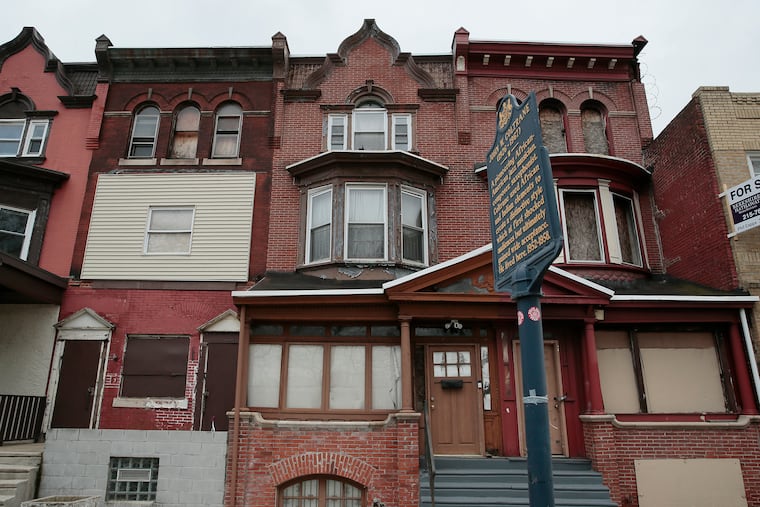Preserving John Coltrane’s house can help save Philly’s soul | Opinion
If we care about Philadelphia’s future, we must preserve this important part of the city’s past.

The jazz saxophonist and composer John Coltrane had a storied career, much of it in Philadelphia. But without intervention, the story of his Strawberry Mansion rowhouse — where he experienced a spiritual awakening, kicked his heroin addiction, and composed the album Giant Steps — will not have a happy ending.
His home is deteriorating right before our eyes. The front steps are crumbling. Drone photos show damage to the chimney, and rotting materials and holes in the exterior wall.
The John Coltrane House, built in 1903, was added to the Philadelphia Register of Historic Places on Dec. 18, 1985. The house was designated a National Historic Landmark, the highest level for a historic property, by the secretary of the interior on Jan. 20, 1999. While there are thousands of properties on the local register, only 67 are National Historic Landmarks, including the Academy of Music, where Coltrane first heard Charlie Parker perform in person.
But neither designation has kept the property from falling into disrepair. The John Coltrane House was recently listed on Preservation Pennsylvania’s 2020 roster of “at risk” sites, a designation intended to “draw statewide attention to the plight of Pennsylvania’s historic resources; promote and support local action to protect historic properties; and encourage funding and legislation that supports preservation activities,” according to the organization.
If we care about Philadelphia’s future, we must preserve this important part of the city’s past.
At the Greater Philadelphia 2020 Tourism and Hospitality Industry Outlook gathering last month, there was a lot of talk about diversity and inclusion, and the growing number of neighborhoods that are “visitor friendly.” Visit Philadelphia unveiled strategies to reach diverse audiences and markets.
John Coltrane is exactly the metaphor for the diversity and inclusion that Philadelphia hopes to achieve and highlight. Coltrane’s Philadelphia was about intersectionality before the term — which refers to the complex and cumulative way that the effects of different forms of discrimination overlap — was coined.
In the 1940s and ‘50s, blacks and whites socialized on an equal basis for the first time at jazz clubs such as Downbeat, Blue Note, and Showboat. Gender bender Gladys Bentley wowed audiences at the Memphis Club, and female impersonators performed at the Checker Café.
The Philadelphia story is more than the Founding Fathers. Preserving Coltrane’s presence in Philadelphia is not solely about the past and public memory. It would be a giant step forward in telling a more complete history. It would send a message to underserved communities that they belong here.
The John Coltrane House could anchor cultural heritage tourism in North Philadelphia. In addition to historic landmarks like the Blue Horizon, Church of the Advocate, Freedom Theatre, and Uptown Theater, North Philly has the second largest cluster of Green Book sites, several of which are on Ridge Avenue in the revitalizing Sharswood neighborhood. Popularized by the Oscar-winning movie of the same name, the Green Book was a travel guide that helped African Americans navigate Jim Crow laws in the South and racial segregation in the North.
The loss of the John Coltrane House would continue the erasure of black presence from public spaces, something I’ve been advocating against as chair of the Historical Marker Monitoring Committee of the Avenging the Ancestors Coalition (ATAC). Formed in 2002, ATAC successfully fought to have it recognized that George Washington held enslaved African Americans at the President’s House at Sixth and Market Streets. Since then, we’ve continued to fight for the preservation of important black landmarks, including Cheyney University, the Bethel Burying Ground, and, of course, the Coltrane house.
My concerns are shared by Maxine Gordon, widow of the saxophonist Dexter Gordon. A jazz historian, Gordon has visited the Coltrane house many times. She wrote in an email: “John Coltrane bought the house for his mother. It stands as a testimony to his connection to the great jazz history of Philadelphia and his family, including ‘Cousin Mary’ Lyerly Alexander, who lived there and devoted her life to preserving his legacy. I urge the City of Philadelphia to support the preservation of this important monument to John Coltrane, who is revered worldwide.”
A good first step in saving this hallowed house would be for Mayor Jim Kenney to use his authority to ask the Department of Licenses and Inspections to inspect the building. The house has not been inspected since 2012. The failure to act is not about limited resources; it’s about priorities. City employees maintain the frequently vandalized Frank Rizzo statue. City employees should conduct an assessment to determine the structural integrity of the National Historic Landmark. From there, decisions can be made about how to move forward.
The city is gearing up for the semiquincentennial, the 250th anniversary of the birth of the United States. Leaders of Philadelphia250, the group coordinating the anniversary, want to go beyond Benjamin Franklin’s Philadelphia and “illuminate the untold histories of our diverse people and neighborhoods.” The world is invited “to partake in a celebration of our diverse passions, interests, cultures, and creativity.”
Serendipitously, 2026 is also the centennial of the birth of John Coltrane. When the country’s and Coltrane’s birthdays are celebrated, it is my hope residents and visitors will see a house befitting of the man who bequeathed to the world “A Love Supreme.”
Faye M. Anderson is director of All That Philly Jazz, a public history project that is documenting Philadelphia’s golden age of jazz. She leads a walking tour of Green Book sites associated with John Coltrane.